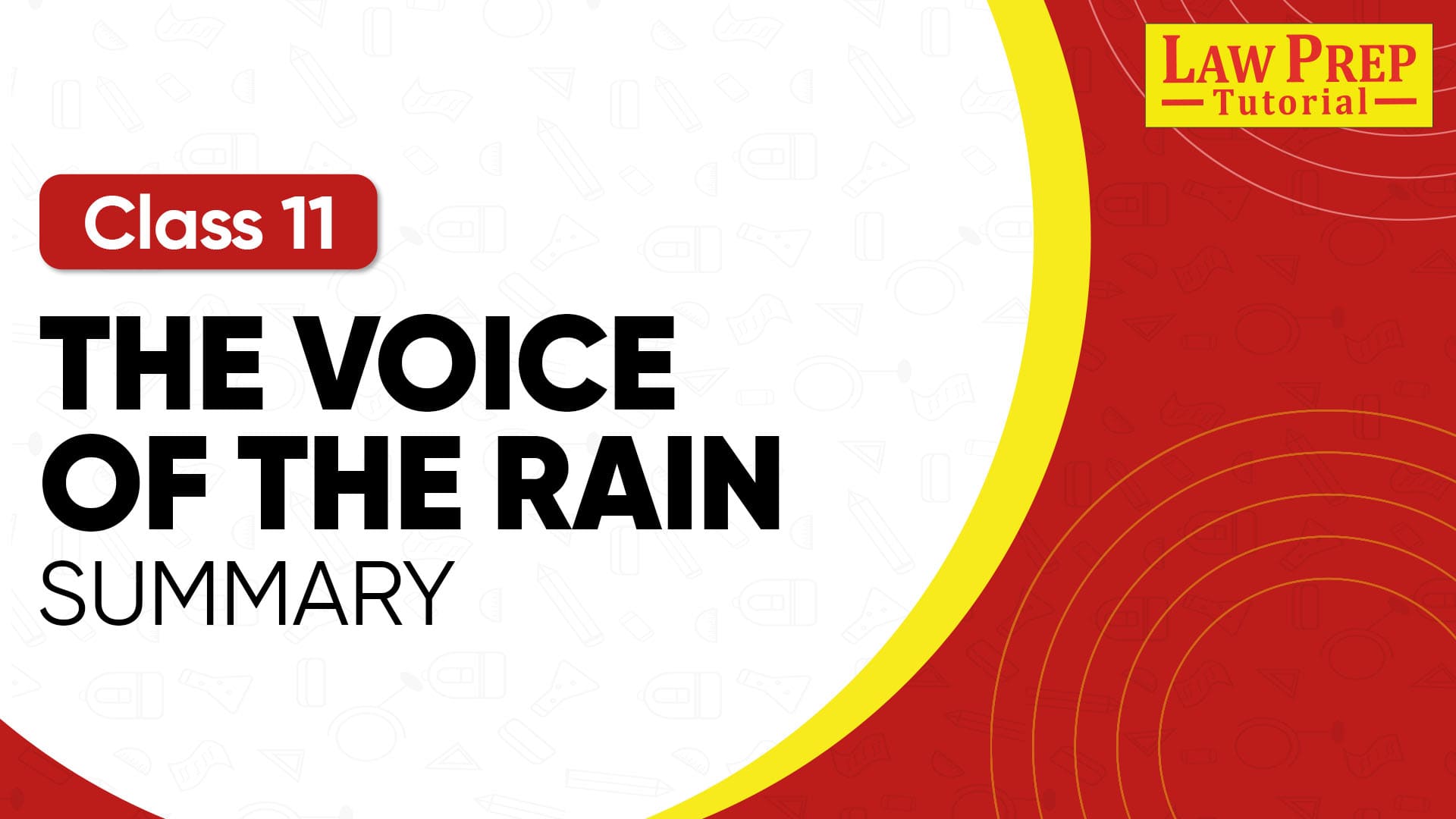If you are studying Hornbill, you will come across Walt Whitman’s poem The Voice of the Rain. In this blog, we will cover The Voice of the Rain summary in a clear and simple way.
You will also understand the central idea and meaning of the poem. The poet presents a dialogue with the rain, where it explains its purpose on Earth and its eternal cycle of giving life. By reading the summary and explanation of The Voice of the Rain, you will easily grasp its theme and prepare better for your exams.
Summary of The Voice of The Rain
The Voice of the Rain by Walt Whitman is a symbolic and conversational poem that presents a dialogue between the poet and the rain. In this piece, the poet asks the rain, “Who are you?” and surprisingly, the rain replies in its own mysterious voice.
The rain introduces itself as the earth’s poem, something that rises unseen from the land and the oceans, drifts upward into the sky, and then descends again in the form of gentle showers. It explains that it is an eternal phenomenon, a continuous cycle that purifies, nurtures, and sustains life.
The rain describes its journey in poetic imagery. It rises as invisible vapour, transforms in the skies, and returns to its origin in a new, life-giving form. While doing so, it quenches the thirst of dry lands, washes away dust, and nourishes seeds hidden in the soil, helping them grow into full-fledged plants.
In this way, the rain highlights its role as a selfless force of nature that works silently for the well-being of the earth.
Whitman draws a comparison between the rain and a song. Just as a song is born from the heart of a poet, travels through the air, touches listeners, and finally returns to the poet with appreciation and love, the rain too originates from the earth, wanders into the sky, showers upon the land, and returns to its source, renewed and complete. This comparison deepens the beauty of the poem and emphasizes the endless rhythm of creation and return.
The poem also underlines the bond between nature and life. Rain is portrayed not just as a natural occurrence but as a nurturing, almost spiritual element that symbolizes regeneration, cleansing, and harmony. Its cycle represents continuity, balance, and the eternal renewal of life on earth.
Through simple yet powerful free-verse lines, Whitman conveys that nature is alive, communicative, and filled with meaning if one listens closely. The rain’s “voice” reminds us that even ordinary natural processes carry profound lessons of selfless service, interconnectedness, and eternal rhythm.
Thus, the voice of the rain poem becomes both a celebration of rain’s life-sustaining role and a reflection on the deeper philosophy of nature’s cycles.

Short Summary of The Voice of The Rain
The Voice of the Rain by Walt Whitman is a symbolic poem that presents a dialogue between the poet and the rain. When asked who it is, the rain responds that it is the “poem of the earth.” It explains its eternal cycle—rising unseen as vapour from the land and oceans, drifting skyward, and returning as gentle showers. In doing so, it cleanses the dusty air, quenches the earth’s thirst, and nurtures seeds, enabling life to flourish.
The rain emphasizes its role as a selfless force of nature that continuously renews and sustains the planet. Whitman compares the rain to a song, which originates from the poet’s heart, travels through the world, and returns with appreciation. Similarly, the rain originates from the earth, wanders in the sky, and comes back to enrich its source. The poem conveys the beauty, harmony, and eternal rhythm of nature’s cycles.
More Important Resources for CBSE Exam:
| Class 11th Hornbill Syllabus | CBSE Class 11th Commerce Subjects |
| CBSE Full Form | All about CBSE Class 11th |
| Class 11th Syllabus | Class 12th Syllabus |
| Class 11th Commerce Books | CBSE Board: All details |
The Voice of The Rain Explanation
Below is the line by line explanation of The Voice of The Rain poem in Class 11th:
Stanza 1
“And who art thou? said I to the soft-falling shower,
Which, strange to tell, gave me an answer, as here translated:”
Explanation:
The poet asks the softly falling rain who it is. To his surprise, the rain responds in its own mysterious voice. Whitman acts as a translator of the rain’s reply, sharing its message with readers.
Stanza 2
“I am the Poem of Earth, said the voice of the rain,
Eternal I rise impalpable out of the land and the bottomless sea,
Upward to heaven, whence, vaguely form’d, altogether changed, and yet the same,”
Explanation:
The rain introduces itself as the “Poem of the Earth.” It describes how it rises invisibly from land and sea in the form of vapour. It drifts upward into the sky, changes its form into clouds, and yet remains the same in essence.
Stanza 3
“I descend to lave the droughts, atomies, dust-layers of the globe,
And all that in them without me were seeds only, latent, unborn;
And forever, by day and night, I give back life to my own origin,
And make pure and beautify it.”
Explanation:
Here, the rain describes its return journey to earth. Falling as showers, it washes away dust and quenches the thirst of the land. It nourishes seeds lying dormant, giving them new life. This cycle continues endlessly, day and night, keeping the earth pure and beautiful.
Stanza 4
“(For song, issuing from its birth-place, after fulfillment, wandering
Reck’d or unreck’d, duly with love returns.)”
Explanation:
In the final stanza, Whitman compares rain to a song. Just as a song comes from the poet’s heart, travels far, touches listeners, and finally returns with appreciation, rain too originates from the earth, wanders in the sky, and returns to enrich its source.
The Voice of the Rain: Central Idea
The central idea of The Voice of The Rain poem is the eternal rhythm of nature’s cycles and the rain’s vital role in nurturing and purifying the earth. It also symbolizes beauty, harmony, and selfless service.
It presents a dialogue between the poet and the rain, where the rain introduces itself as the “poem of the Earth.” It explains its eternal cycle—rising as vapour from land and sea, forming clouds, and returning as showers to cleanse, nourish, and beautify the earth. The rain’s role is selfless, as it sustains life and renews nature without expecting anything in return.
Whitman compares the rain to a song, which originates in the poet’s heart, travels through the world, and finally returns with love and appreciation. In the same way, rain returns to its source after completing its life-giving journey.
Read the chapter-wise summaries of Class 11 English here:
About the Poet of The Voice of the Rain: Walt Whitman
Walt Whitman (1819–1892) was a celebrated American poet, essayist, and journalist, often called the “Father of Free Verse.” His most famous work, Leaves of Grass, broke traditional poetic forms and celebrated democracy, individuality, and the unity of humanity with nature.
Whitman’s poetry reflects his deep love for nature, spiritual philosophy, and belief in the interconnectedness of all life. In The Voice of the Rain, he personifies rain to show its eternal life cycle and its role as a selfless nurturer of the earth, blending natural imagery with a philosophical message.
The Voice of the Rain: Theme
The theme of The Voice The Rain poem is, therefore, the harmony between nature and life, the beauty of selfless giving, and the eternal rhythm of creation and renewal.
Walt Whitman’s The Voice of the Rain explores the eternal cycle of rain and its life-giving role on earth. The poem highlights how rain rises invisibly from the land and oceans, transforms in the sky, and returns as showers to purify, nourish, and beautify the world. It symbolizes renewal, continuity, and the selfless service of nature.
Another important theme is the comparison of rain to a song. Just as a song originates in the poet’s heart, travels far, and finally returns with appreciation, rain too begins from the earth, fulfills its purpose, and returns enriched. Through this, Whitman conveys that natural processes and human creativity share a universal rhythm of origin, journey, and return.
Poetic Devices in The Voice of the Rain
| Poetic Device | Example from the Poem | Explanation |
| Personification | “I am the Poem of Earth” | The rain is given a human voice and identity. |
| Metaphor | Rain compared to the “Poem of the Earth” | Shows rain as a creative expression of nature. |
| Imagery | “I descend to lave the droughts, atomies, dust-layers” | Vivid visual images of rain cleansing and nourishing. |
| Symbolism | Rain as a symbol of renewal and life | Represents the eternal cycle of nature and selfless service. |
| Repetition | “And forever, by day and night” | Emphasizes the continuous, unending role of rain. |
| Simile (Implied) | Comparison of rain to a song (not direct with “like/as”) | Suggests both follow a cycle of origin, journey, and return. |
| Free Verse | Entire poem | No rhyme scheme or fixed meter; reflects natural flow of thought. |
The Voice of the Rain: Word Meanings
| Word | Meaning |
| Soft-falling shower | Gentle rainfall |
| Impalpable | Something that cannot be touched or felt physically |
| Bottomless sea | Vast, deep ocean |
| Vaguely form’d | Not clearly shaped; indistinct |
| Lave | To wash or bathe |
| Droughts | Long periods without rain, dryness |
| Atomies | Tiny particles or specks of dust |
| Latent | Hidden, not yet developed |
| Unborn | Not yet come into existence |
| Fulfillment | Completion or achievement of purpose |
| Reck’d or unreck’d | Whether cared for or not; with or without recognition |
Find detailed questions and answers from all chapters of English Class 11 now:
FAQs About The Voice of the Rain
The Voice of the Rain is written by Walt Whitman, one of the greatest American poets, known as the “Father of Free Verse.”
The central idea is the eternal cycle of rain, which rises from the earth, transforms in the sky, and returns to purify, beautify, and sustain life.
The rain calls itself the “Poem of the Earth” because, like a poem, it originates naturally, nurtures life, brings beauty, and finally returns to its source after fulfilling its purpose.
Rain is compared to a song because both originate from a source, travel outward, fulfill their purpose, and return enriched with love and recognition.
“Reck’d or unreck’d” means whether it is cared for or ignored. The rain, like a song, fulfills its purpose regardless of recognition.
The poem is written in free verse, without rhyme or fixed meter, which reflects the natural, flowing rhythm of the rain’s voice.
It helps students appreciate the beauty of nature, understand the deeper meaning of rain’s life-giving cycle, and develop a literary sense of symbolism and personification.
Check the latest CBSE Class 11 syllabus for all subjects below:
Explore the updated CBSE Class 12 syllabus for all subjects here:
Discover CLAT exam resources that can help you get started early:
Explore CLAT coaching centers across different cities:


